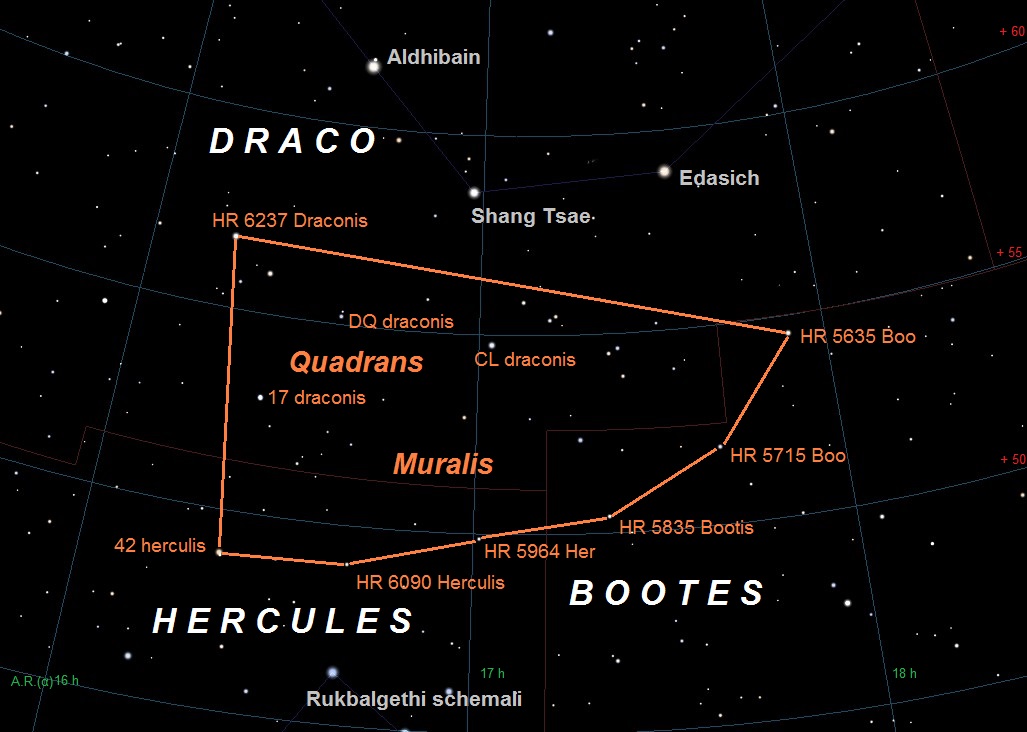
The new astronomical year begins, as every year, with a rain of “shooting” stars, the Quadrantids, which this year will peak in Greece and the rest of the northern hemisphere early on the night of Monday, January 3, at about 22:40 Greek time.
This year’s Quadrantids could prove to be even the best such phenomenon of the year, according to the Royal Astronomical Society, as conditions this year will be ideal for observation, as there will be a New Moon on January 2, so the night sky will be dark, while the next full moon – the first of 2022 – will occur on the night of Monday, January 17.
In fact, shortly after the climax of the Quadrantids, on the morning of Tuesday, January 4, at 08:52 Greek time, the Earth will be at its perihelium, ie at the closest point of its orbit from the Sun.
Up to 50 meteors per hour
Quadrantids are best visible at the northernmost latitudes, especially in a northeasterly direction in the sky. They peak at up to 50 meteors per hour, entering the Earth’s atmosphere at speeds of more than 40 kilometers per second, while up to 120 meteors have been reported in some years. It is a drizzle of shooting stars that is considered better than average, although it is less known than others such as Leonids, Orionids and Geminids, as its meteors are fainter, but often illuminate the sky with unusually giant “tails”.
How the Quadrantids got their name
This rain of “shooting stars” takes its name from a faint constellation (Quadrans Muralis or mural quadrant – was an old astronomical instrument before the invention of the telescope), which was discovered by the French astronomer Jerome Lalad in 1795, but no longer exists. In 1922, Quadrans Muralis was omitted when the International Astronomical Union (IAU) formalised its list of officially recognized constellations.
Today the source of the meteors seems to be the constellation of Bootes, in which the Quadrans Muralis was incorporated in 1922, when the International Astronomical Union identified the 88 constellations that exist today.
Astronomers are still unsure of the passing comet, which left behind a tail of dust and particles that turn into meteors each time the Earth crosses its orbit.
It is possible that it is the asteroid “2003 EH1” with a diameter of about two kilometers, which is the remnant of a former comet, C / 1490 Y1. The asteroid was officially discovered in 2003, but the mother comet was first observed by Chinese, Japanese and Korean astronomers as early as the 15th century. The first observations of the Quadrantids in Europe were made by the Brussels Observatory in 1825.
Latest News

Airbnb: New Measures Add €600 in Extra Costs for Property Owners
Property managers face an immediate administrative fine of 5,000 euros if access to the inspected property is denied or any of the specified requirements are not met.

Economist: Greece Included in the Best Performing Economies in 2024
Meanwhile, Northern European countries disappoint, with sluggish performances from the United Kingdom and Germany.

EasyJet Expands Its Routes from Athens
The airline’s two new routes will be to London Luton and Alicante and they will commence in summer 2025.

Capital Link Forum Highlights Greece’s Economic Resurgence; Honors BoG Gov Stournaras
Capital Link Hellenic Leadership Award recipient, Bank of Greece Gov. Yannis Stournaras, an ex-FinMin, was lauded for his pivotal role during Greece’s economic recovery

Tourist Spending in Greece Up by 14%, Visa Card Analysis Shows
Greece’s capital Athens emerged as the most popular destination, recording a 17% increase in transactions with Visa cards, surpassing even the cosmopolitan island of Mykonos.

Inflation in Greece Unchanged at 2.4% in Nov. 2024
The general consumer price index (CPI) posted a 0.4% decrease in November compared to the previous month

2024 Christmas Holidays: Extended Shop Hours Schedule
The 2024 Christmas Holidays extended shop hours schedule commences on Thursday, December 12 and runs until the end of the year.

ELSTAT: Seasonally Adjusted Unemployment Down in October
The number of employed individuals reached 4,284,694, an increase of 67,723 compared to October 2023 (+1.6%) and 22,002 compared to September 2024 (+0.5%).

Greek PM’s Chief Economic Adviser Resigns
In the post on his Facebook page, Patelis did not disclose the reasons that led him to step down.

“Masdar Invests in the people of Greece and in the vision of TERNA ENERGY”
Four messages from the CEO of Masdar, the Arab renewable energy giant, after its acquisition of 70% of TERNA ENERGY













![Fraport: Πάνω από 35 εκατ. επιβάτες στα αεροδρόμια το 11μηνο – Πτώση στη Μύκονο [πίνακας]](https://www.ot.gr/wp-content/uploads/2022/06/fraport-90x90.jpg)

























![Fraport: Πάνω από 35 εκατ. επιβάτες στα αεροδρόμια το 11μηνο – Πτώση στη Μύκονο [πίνακας]](https://www.ot.gr/wp-content/uploads/2022/06/fraport-600x375.jpg)


 Αριθμός Πιστοποίησης Μ.Η.Τ.232433
Αριθμός Πιστοποίησης Μ.Η.Τ.232433